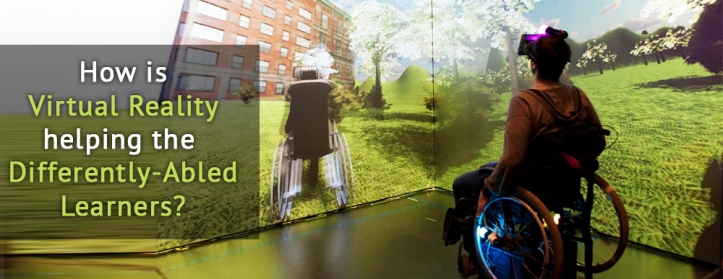Summary
From helping differently-abled students to view heavenly bodies in the distant sky, to letting them perform virtual rehearsals to become better at communication and social skills, virtual reality can prove to be immensely beneficial for specially-abled learners. Find out how the technology can be put to use to make learning fun, interesting, and productive for the differently-abled.

Virtual Reality in education has the power to transform the process of learning by providing learners with highly engaging content and a number of outstanding benefits. Already proven to be immensely successful in the world of gaming and entertainment, the technology is all set to revolutionise the realm of education as well. But do you know virtual reality can make the process of learning a lot easier for the differently-abled learners? Here is how Virtual reality in education is helping the specially-abled students in learning and acquiring new skills.
How does Virtual Reality help differently-abled learners?
Virtual reality in education is coming out to be highly beneficial for modern learners. And the benefits don’t end here as the technology can also be effectively used to help learners with disabilities such as hearing impairment, vision impairment, etc. Read through to find out how virtual reality can be used to help the specially-abled students.
Virtual reality for the Physically Disabled
Physically disabled students may not be able to participate in outdoor activities such as trekking, hiking, or mountain climbing. Some of them may not be able to be a part of school field trips as well. Virtual reality in education helps these learners travel to the most inaccessible parts of the planet and immerse in an experience that leaves a deep impact on their minds. Virtual reality in education can also be used to make physically disabled students practice various skills such as driving a car or to learn how to operate a wheelchair.
Virtual Reality for Hearing Impairments
Content used in virtual reality applications is exceptionally interactive and consists of high-quality graphics. To make lessons easier for the hearing impaired and deaf, virtual reality acts as an excellent tool. Advancements in technology have led to the development of virtual reality apps that make use of devices such as project display systems with pinch gloves that lets these students learn without any difficulties and limitations, by making use of the senses of vision and haptics.
Virtual reality for the Visually Impaired
There are plenty of virtual reality applications that are designed to help the visually impaired in the process of learning. While the visually impaired may find it difficult to read the textual content, these applications come with voiceover and the feature to talk back to make the process more interactive. Also, apps like the Night Sky help such students view the heavenly bodies in the sky which they cannot do with the naked eyes.
Virtual Reality for Sensory Impairments
Sensory impaired people find challenges in one or more of these senses- hearing, vision, and touch. Hence, the way they perceive things and respond is a little different from the others. Virtual Reality may not be able to eradicate the problem but can help people with sensory impairments develop cognitive and functional skills. Special virtual reality applications are designed in a way that they can orchestrate the inputs and outputs of hearing and vision. To make the process more interactive, these apps make use of haptics such as digital pen, gloves, joysticks, etc,
Virtual Reality for the Autistic
Students with autism often find it challenging to be actively involved in the processes of nonverbal and verbal communication, and social interaction. Learning a language, controlling their behaviour and mood can also emerge as a problem for individuals with autism. This is where virtual reality comes into use. Specially designed virtual reality applications allow students with autism to learn communication with complete independence. One such example is the AS Interactive Project that is designed to make autistic students learn how to engage and respond in different social situations.
The Many Benefits of Virtual Reality for the Differently Abled Learners
There are learning management software out there that come equipped with virtual reality. These LMS are so designed that they utilise the benefits of virtual reality in education to the fullest. And below are the many benefits of virtual reality for differently-abled learners.
Better Interaction
Interacting with others is not easy for specially-abled learners. It may be because of a physical impairment or the way they perceive things. This is when virtual reality comes to the rescue. With special virtual reality applications, educators can use virtual reality to train differently-abled students with social skills.
Tailored Content
Textual or visual content is not sufficient for differently-abled students. Hence, virtual reality applications designed for these learners come with specially curated content that has the potential to leave an impact on them. Also, they can decide what content they want to view and thus indulge in an immersive experience.
Providing Safe Spaces
It’s not easy for differently-abled individuals to learn and interact in a room full of people. Virtual reality applications let such students learn even at their homes and at their own pace. Be it practicing a social skill or preparing for a school event, virtual reality lets them do it all. When they feel safe in a place, they can understand things better and thus become better learners.
No More Distractions!
This is one of the most remarkable benefits of virtual reality. The technology lets you fully immerse yourself in a virtual environment, cutting you off from the real world and all the distractions. This works well for differently-abled students as well as they find it difficult to concentrate in a crowded place.
Virtual reality in education cannot be considered anything less than a boon. The technology has immense potential to help transform the world of education for differently-abled learners and make them understand things in a better way.
